Rich Communication Service Template Creation
Welcome to WebEngage's Guide to getting started with RCS Business Messaging
While you will be using WebEngage to create and analyze all your RCS campaigns, the message is delivered to your target audience through a Rich Communication Service Provider (RSP).
Please Ensure That Your Website & Apps Are Integrated with WebEngage Before Proceeding(Doing so will enable real-time personalization of all RCS messages sent to each user!)
Getting Started with RCS Marketing
Strict guidelines laid down for RCS marketing. Hence, you must follow these steps to ensure that you can use RCS uninterruptedly through WebEngage.
Step 1: Get Message Templates Whitelisted
Message templates are pre-approved messages that can contain a maximum of 4096 characters including elements of personalization, links, emojis, and RCS specific formatting. These messages can be used to initiate a conversation with opted-in users (through campaigns)
To curb marketing spam, RCS has mandated whitelisting for each message that you'd like to send to your users. Promotional marketing is restricted, and the primary focus of this new channel is to provide customer support and contextual lifecycle updates. This means that early adopters can stand out - if you do it right!
-
Thus, we highly recommend that you restrict RCS campaigns to conveying account updates, appointment updates, payment updates, personal finance updates, reservation updates, shipping updates and providing issue resolution.
-
Messages that contain any of the following elements are at a high risk of being disapproved:
- Discounts, promotions, product recommendations or offers.
- Surveys, product/service reviews, and rating requests.
- Media files (videos & images).
-
You can submit message templates on your RSP dashboard for approval. Once they're approved, upload these templates to your WebEngage dashboard to create RCS campaigns.
Whitelisting Personalized Message Templates
Depending on your use-case, there may be several aspects that you'd like to personalize in the message. It could be anything like the user's name, name of purchase product(s), order number, date of appointment, upcoming events, and so on.
This can easily be achieved by:
-
Step 1: Tracking these data points as Custom User Attributes, Custom Events, and Custom Event Attributes for all your app & web users.
-
Step 2: Creating a placeholder in your message template for links, emojis, and personalization. Let's take the example of an order confirmation message that contains the following details:
- User's First Name
- Order Number
- Order Tracking Link
- An Emoji
Thus, while creating the message template, we'll replace each element with a placeholder in the format, {{x}}. Here's what the final template should look like:
Whitelisting Order Confirmation MessageHey {{1}}, thanks for your order!
We'll keep you posted on when it's ready to be shipped! You can track order number {{2}}, here {{3}}. Stay awesome {{4}}
So, the message received by a user, Jess, will look like this👇:
RCS Message Receive by UserHey Jess, thanks for your order!
We'll keep you posted on when it's ready to be shipped! You can track order number 45360d, here www.example.com/order-tracking/45360d. Stay awesome 🤙
Step 3: Collect User Opt-ins
By default, all users that have a valid phone number listed in their WebEngage User Profile are considered reachable via RCS.
-
Please ensure that you capture the user's country code along with the phone number. If a country code doesn't exist, then RCS will try sending the message to a user by appending the country code of your business phone number.
-
Each time a user provides consent, you can track it as the System User Attribute,
we_rcs_opt_inand set the status totrue. Doing so will make the user reachable via RCS in your dashboard.
Setting RCS Opt-in Status for UsersOur platform integration SDKs enable you to set a user's opt-in status for RCS, WhatsApp, SMS, and Email. You can also choose to pass this data through a Rest API integration or manually upload it to your dashboard Manual CSV Upload
Please Note: _It's extremely important that you opt-in only those users who have explicitly provided consent.
- You can also promote RCS subscription through contextual Push, In-app, SMS, On-site Notifications, Web Push, and Email campaigns that convey the value proposition of connecting with you over the channel.
Rich Communication Service Provider (RSP)
You can think of RCS Service Providers as middlemen that transmit the message from your WebEngage account to a user's RCS account. Currently, you can leverage Sinch to engage users via RCS. We'll be adding more RSPs to the stack pretty soon!
RSP Integration
As highlighted below, access RCS through the Data Platform> Integrations > RCS Setup (Configure) menu on the left side of your dashboard. Click the Add RCS Service Provider button to get started.
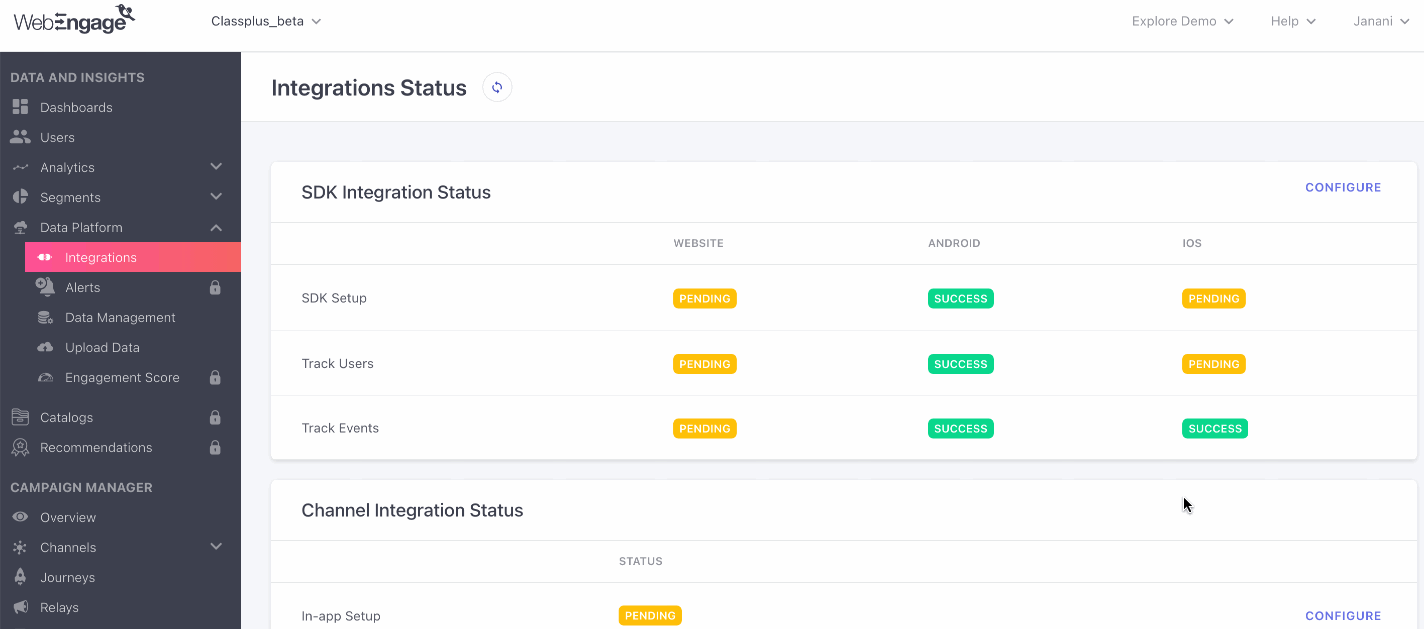
Click to enlarge
RSP SetupPlease select a RSP from the left navigation panel (Channel Configurations > RCS) to continue configuration.
Uploading Whitelisted Templates
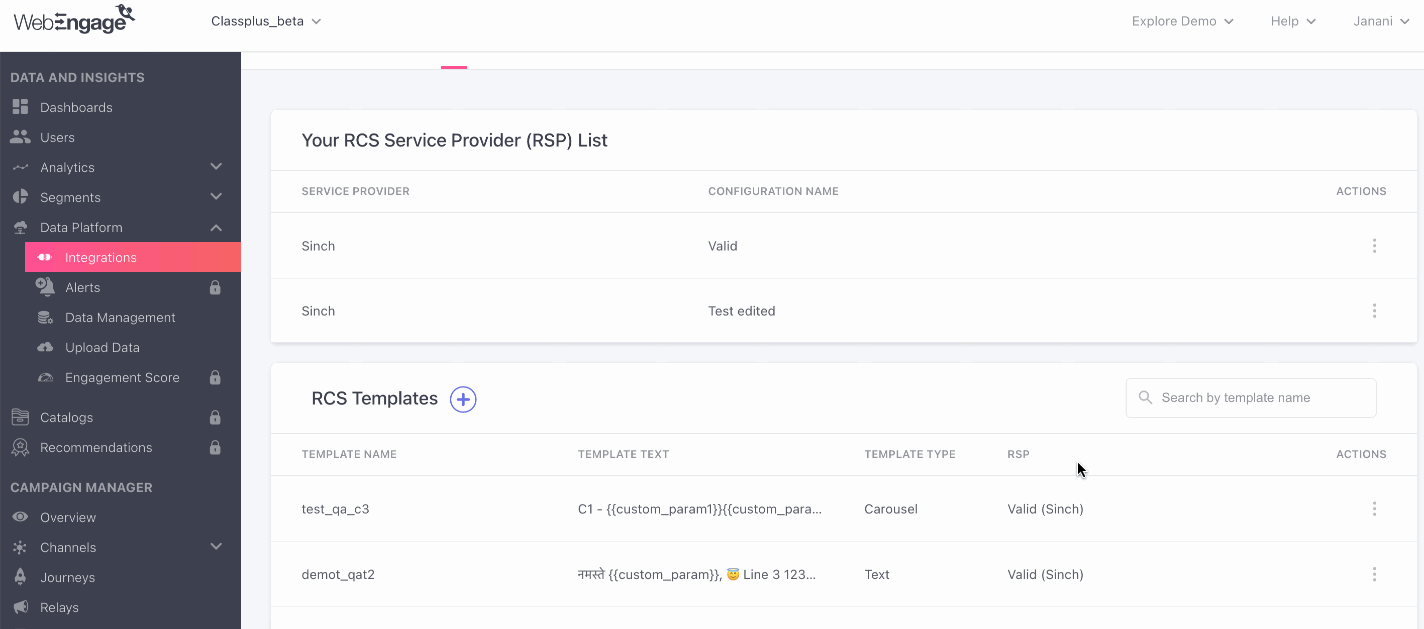
Click to enlarge
As shown above:
Step 1: Click the Add RCS Template button to get started.
Step 2: Select the RSP through which you've whitelisted the template or would like to send the campaign.
Please NoteEach template is mapped to a RSP in your dashboard. Thus, while creating the campaign, the list of templates will include only those messages that have been mapped to the RSP selected at Step 3: Message.
Step 3: Add template details (may vary for each RSP):
-
Template Name- Paste the exact name that has been approved.
-
RCS- Choose the RCS integration.
-
Template Type- Choose between Text, Rich Card, Rich Carousel
Text Template
Once you choose the text template, you are then presented with the following fields to fill to create a template.
Template text: In this section you may start adding the text component of your text template. In this template format, you can add upto 11 buttons.

Rich Card Template
On choosing the Rich Card Template you will be able to add an image along with your content, where you can change the Orientation and Height of your image, after which you can proceed to adding your template details, and uploading the image of your choice, either by providing a link or uploading from your files. By choosing this template you will be able to add upto 4 buttons.

Rich Carousel Template
On choosing the Rich Carousel Template you will be able to add upto 10 images along with content for each of the carousel, in the media settings you can change the card width and media height of your image, after which you can proceed to adding your template details for each of the carousel, and uploading the image of your choice, either by providing a link or uploading from your files.
Note: You will be able to add upto 10 carousels in your template and upto 4 buttons.
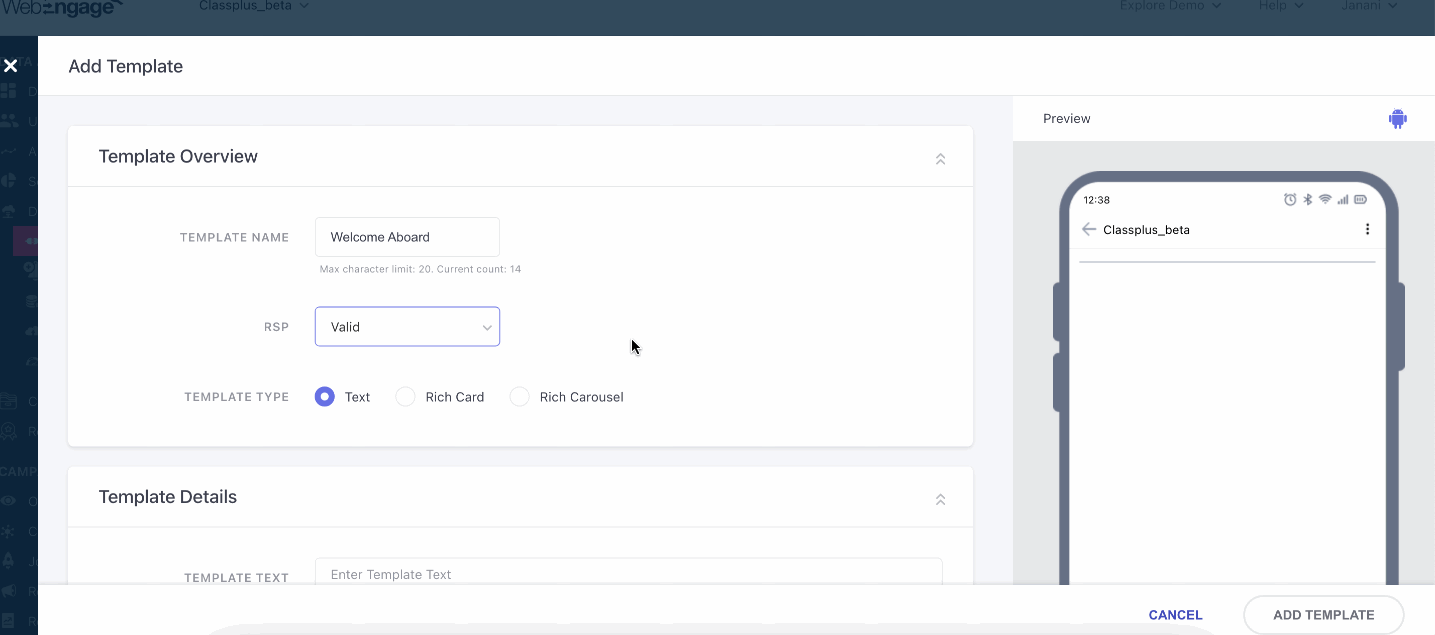
You can view your saved templates on the RCS integration page under RCS templates.
Once you've added the templates, your Channels > RCS section will look like this👇. You can choose to Edit and Delete a template anytime you through the Actions menu.
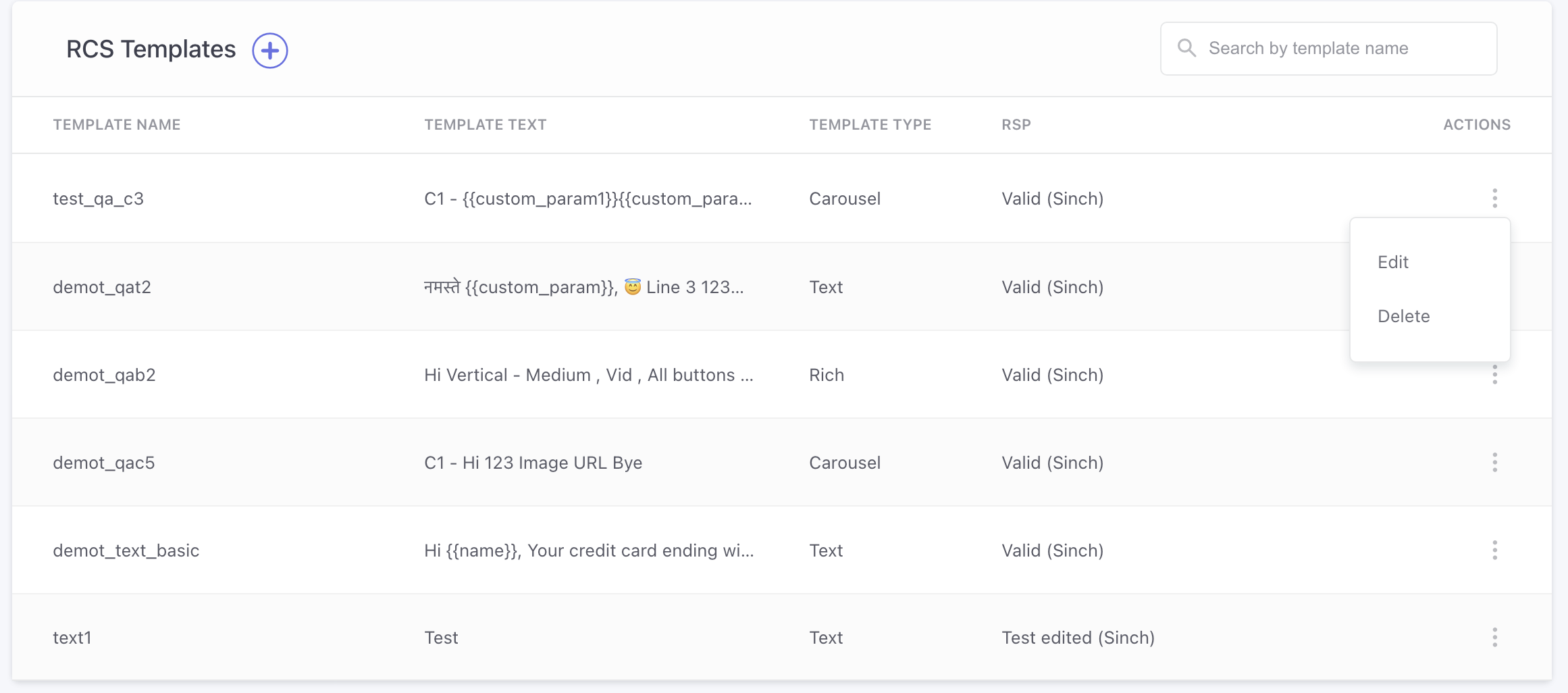
Click to enlarge
Congratulations!You're now ready to engage users via RCS!
Managing Configuration
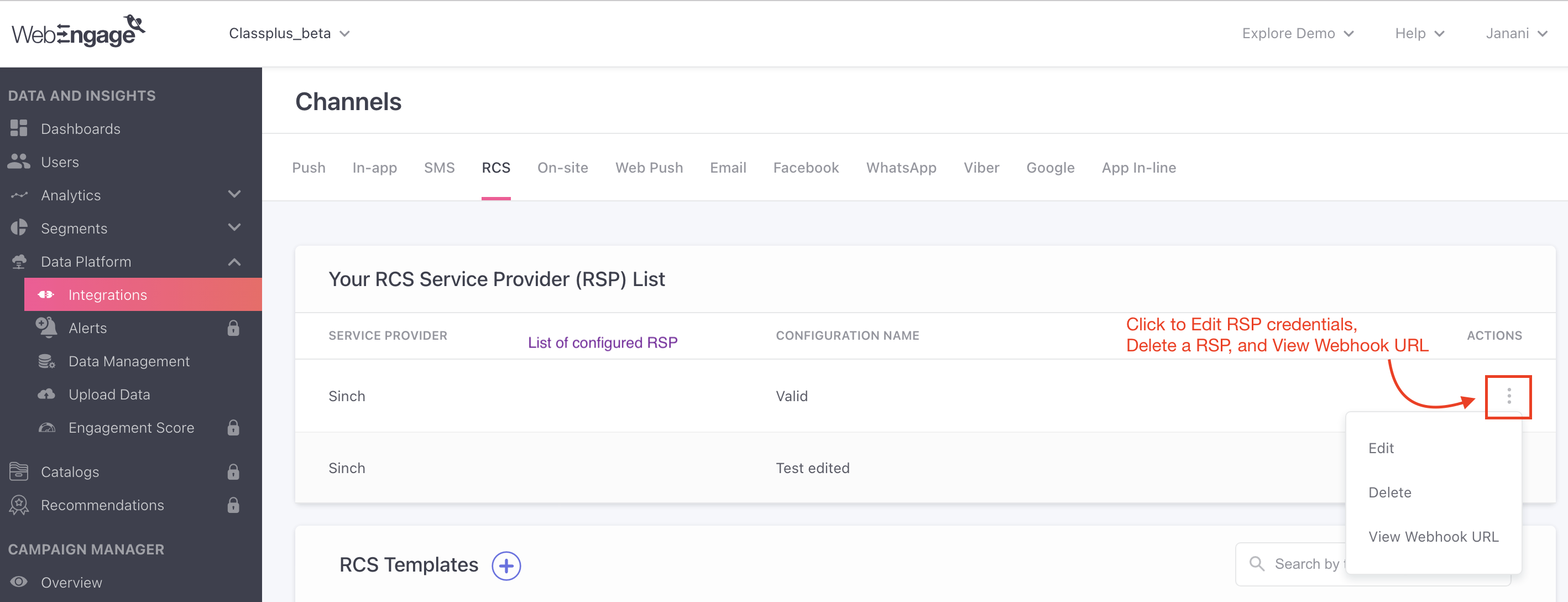
Click to enlarge
As shown above, integrated RSPs are listed under the section, Your RCS Service Provider List. You can choose to Edit or Delete the integration anytime you like by accessing the Actions menu placed on the extreme right.
The Actions menu also indicates the unique Webhook URL you can add to your RSP dashboard to ensure that delivery status notifications (sent, failed, queued, delivered) are tracked under campaign stats in your WebEngage dashboard.
Editing a RSP
You can choose to edit configuration details in cases where incorrect details were entered during configuration, or some details were updated at the RSP's end post-integration.
As shown below, select Edit from the Actions menu, make your changes, and click Save.

Adding more authentication headers to configuration & updating it's name (click to enlarge)
Deleting a RSP
Deleting an integration will:
-
Cease campaign delivery for all Running and Upcoming campaigns where the respective RSP was selected for sending it.
-
Cause the deletion of all RCS Templates mapped to the specific RSP in your dashboard.
Thus, while doing so, please ensure that no existing campaigns are dependant on the RSP for sending RCS messages to your users.
As shown below, select Delete from the Actions menu, and click the Delete button in the pop-up to confirm your decision.
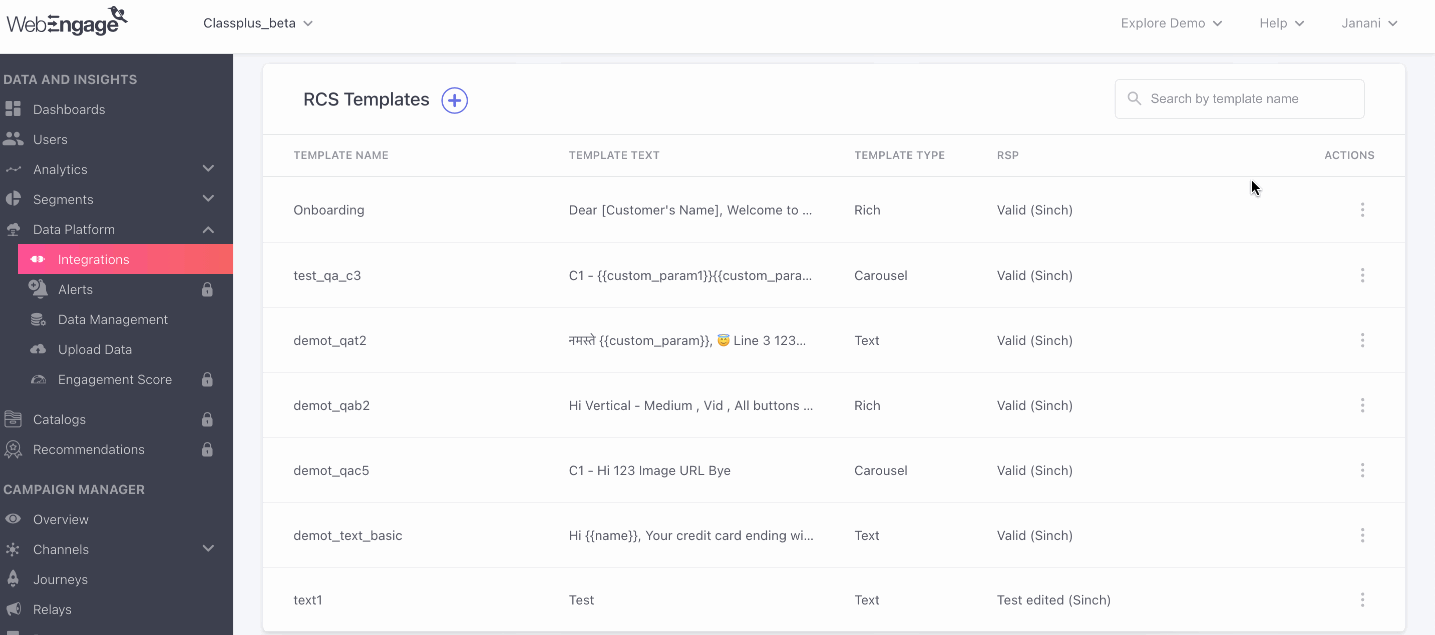
Click to enlarge
Please feel free to drop in a few lines at [email protected] in case you have any queries. We're always just an email away!
Updated 2 months ago